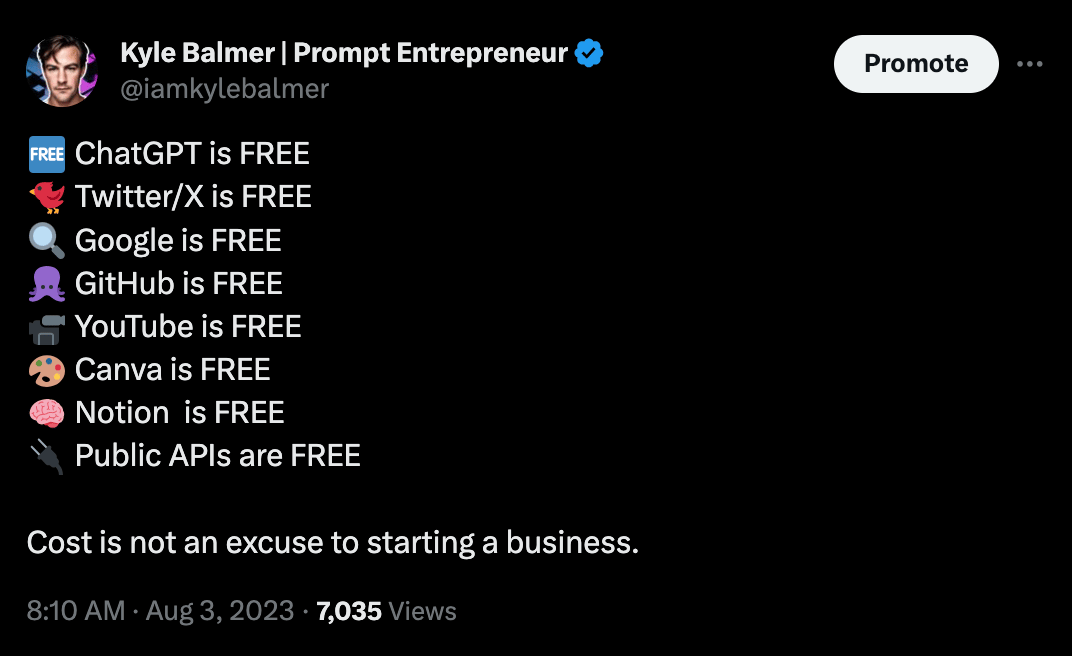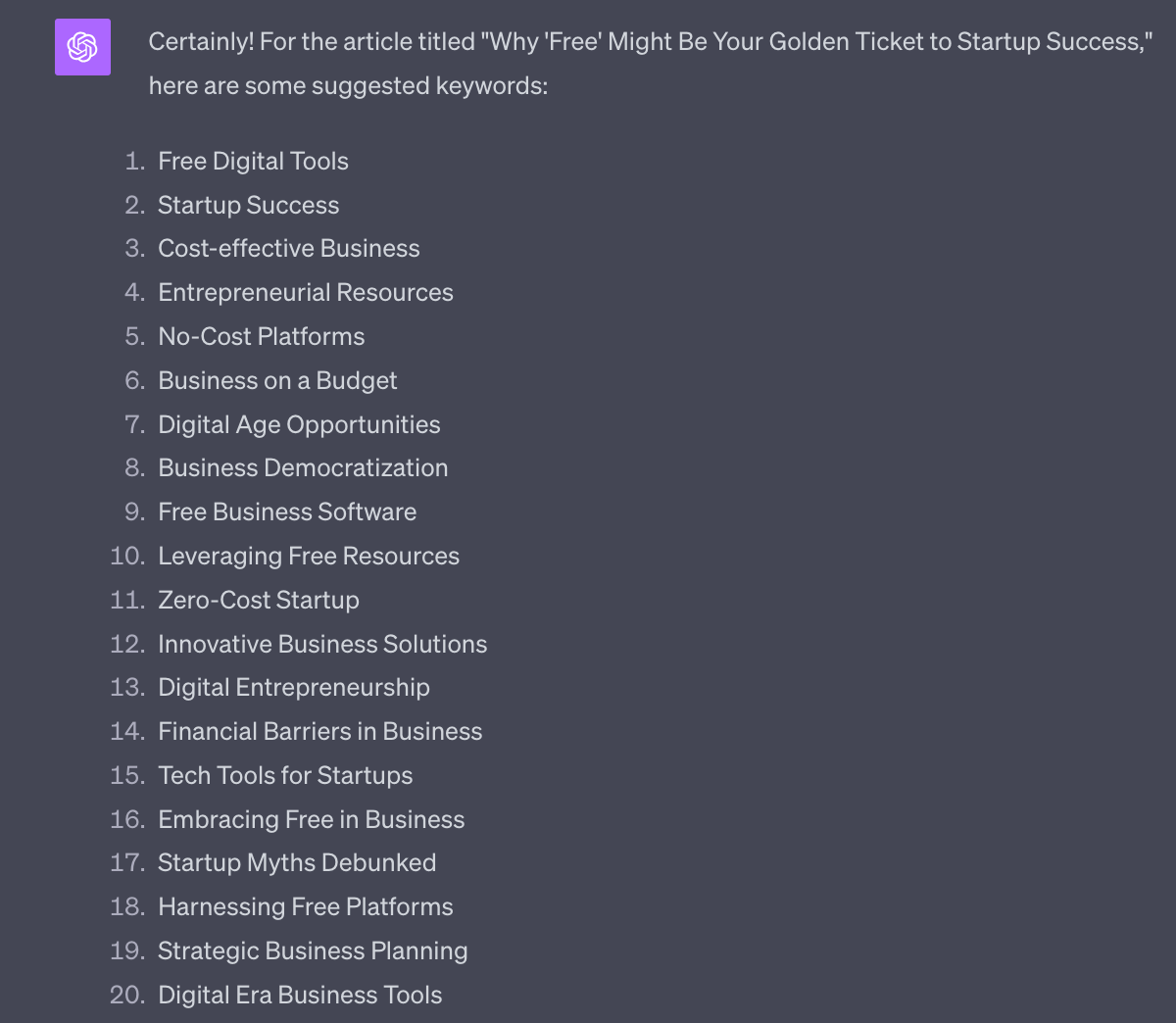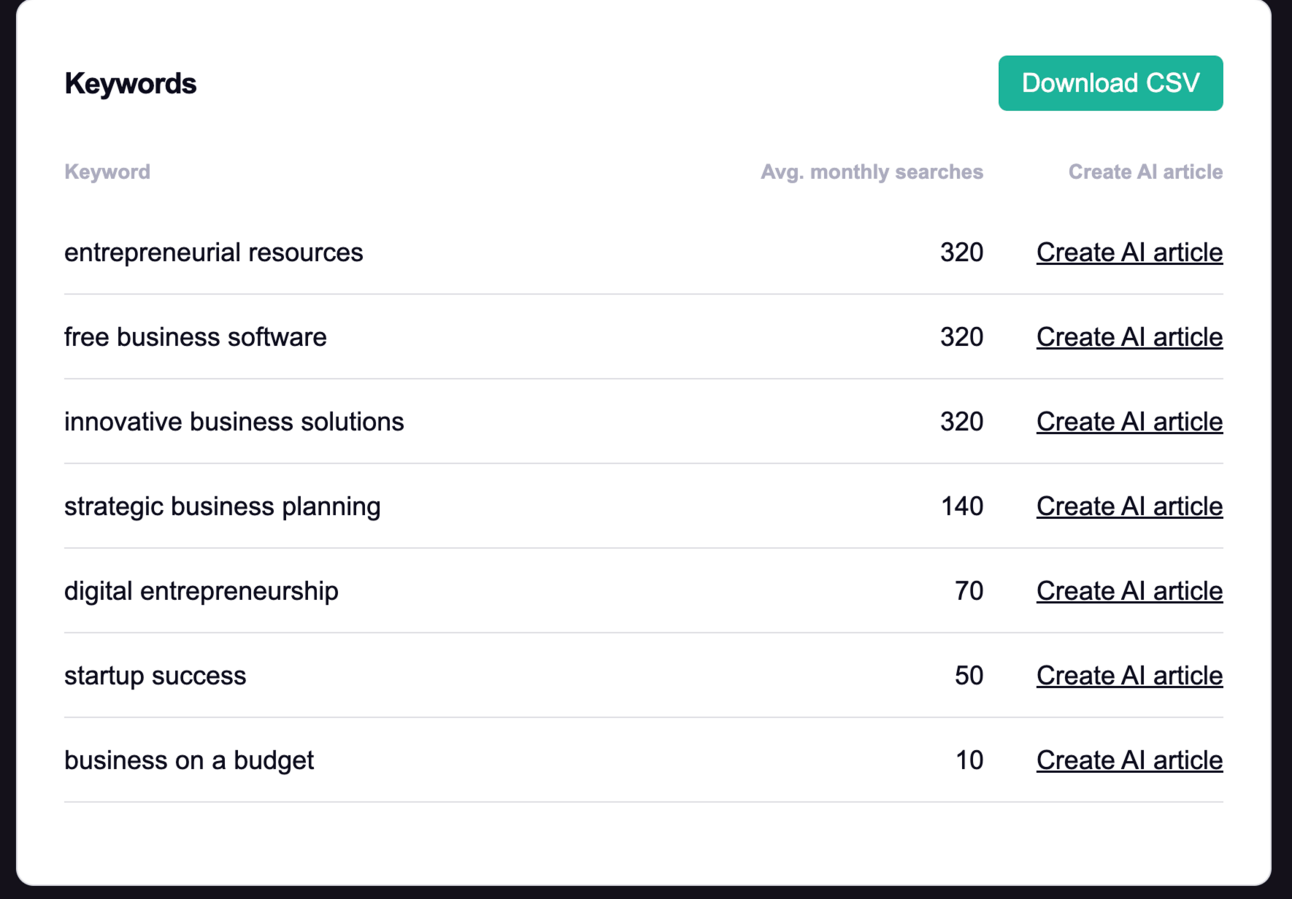Hey Prompt Entrepreneur,
In this Part we move from social media traffic over to Google.
SEO stands for “search engine optimisation” which is a fancy way of saying “getting to the top of Google”.
This is a very complex subject with lots of subtleties. But the general gist is you need to create quality content that Google wants its searchers to find.
If the content is valuable for Google’s users then Google will prioritise it.
All the technical tricks and tactics around this are supplements – nail the content itself and you’ll be golden.
Why do we care about SEO? If you get SEO up and running then Google will send free traffic, in large volumes, to you. For a long time.
I have websites from 10 years ago that make sales purely off people finding the product on Google.
You may be asking – wait, isn’t AI generated content penalised by Google? The answer is yes and no.
No in the sense that Google hasn’t yet caught up and bee able to reliably detect AI generated content accurately enough to penalise it.
But – let’s assume that they one day will be able to. This is the reason why we shouldn’t just wholesale generate SEO content using AI. It will probably get slapped by Google further down the line. Google is smart.
This is why we are not creating content from scratch but instead repurposing existing content that we’ve actually written. AI content is generic and detectable when it’s purely generated by AI.
Instead we’re feeding in the inputs (our own content) meaning that our content will be more hand crafted and “human”.
Let’s get started:
SEO repurposing
1. Simple blog posts
First up let’s look at repurposing into a simple blog article.
The best source for simple blog articles are single posts that we do well on X and LinkedIn.
You can check your best performing X posts in Analytics or by using a free plugin called Tweet Hunter X (on Chrome). Also you can quickly check each week to see which of the week’s posts had the highest view and comment count – this manual method works fine.
Here’s an example of a simple post of mine that did quite well:

Because this seemed to strike a chord I might want to extend this into a blog article for Google SEO.
Here’s the prompt:
Act as an expert SEO writer.
Repurpose the post I provide into an SEO optimised blog article.
Follow these guidelines:
-Write strong headlines that create curiosity and compel readers to click. Avoid exaggerated clickbait titles.
-Capture attention immediately in the introduction by connecting with readers' interests and pain points.
-Preview the value they will get from reading more.
-Break up long sections of text with images, videos, subheadings, whitespace, and other formatting to make it scannable. Include a visually compelling table of contents.
-Tell a cohesive story focused on the reader's needs and interests. Avoid including irrelevant details just for length.
-Ensure content flows logically, transitioning smoothly between sections. Every word should engage readers and move the story forward.
- Each sections (preceded by a header) should have at least 3 paragraphs.
Produce 750-1000 words.
Do not include html.
💬 Prompt Output:

ChatGPT will go ahead and generate a first draft of a blog article for us.
It’s basically fine – it’s captured the main points and is readable.
2. SEO optimisation
You could post this blog article as-is. It will help you rank on Google.
But we can do a little better by performing some very basic SEO optimisation.
We’re not going into detail here on SEO because it’s a big subject. I’ve prepared a whole Prompt Playbook elsewhere if you do want to delve in more.
Instead we’re going to do a basic optimisation and be more intentional in our posting.
Under the existing blog post use this basic prompt:
Suggest SEO keywords.💬 Prompt Output:

ChatGPT will pull some keywords out of your article.
Let’s then go check their volume – ie. how many people search for these terms each month.
If you have access to Google Ads go ahead and do a volume search here.
Otherwise let’s keep it simple and use https://searchvolume.io/
This is a free tool that will check search volume for you. Copy paste all the keywords into the tool to collect volume:

I know grab the top 3 keywords here.
In this case it’s “entrepreneurial resources”, “free business software” and “innovative business solutions”.
We now have to use some judgement – which of these is actually related to our topic. I’d use “entrepreneurial resources” and “free business software” and drop “innovative business solutions”
I now head back to ChatGPT and use this prompt, again below the existing blog article.
Optimise the blog article for:
[copy/paste keywords]Blend the target keywords into title, headers and body organically. Do not highlight the keywords Provide the whole article
💬 Prompt Output:
Here’s the first part of the optimised article:

ChatGPT has gone ahead and adjusted the text to make sure that the target keywords appear.
Do final checks and edits and then post to your blog when happy.
3. Long blog posts
The previous steps provide us with solid smaller blog posts that we can fill our blog with on a daily basis.
However, for SEO it’s also useful to produce much longer, quality pieces. Ideally these should be pages that people bookmark and come back to again and again.
The ideal content for these type of blog articles are in-depth how-to guides.
If you have how-to based content on X or LinkedIn (or any other source) then let’s turn it into a long blog post.
Ideally collect up a number of X long form / LinkedIn articles around a single topic.
We can feed in multiple content pieces to give ChatGPT even more content to work with.
Then use this prompt:
Act as an SEO blog writer.
Analyse and synthesis the content pieces I've provided into a coherent long form blog article
Ignore the order I provide the content. Ignore the structure of the content pieces themselves. Use the information from the content pieces to construct a brand new blog article.
Follow these guidelines:
-Write strong headlines that create curiosity and compel readers to click. Avoid exaggerated clickbait titles.
-Capture attention immediately in the introduction by connecting with readers' interests and pain points.
-Preview the value they will get from reading more.
-Break up long sections of text with images, videos, subheadings, whitespace, and other formatting to make it scannable. Include a visually compelling table of contents.
-Tell a cohesive story focused on the reader's needs and interests. Avoid including irrelevant details just for length.
-Ensure content flows logically, transitioning smoothly between sections. Every word should engage readers and move the story forward.
- Each sections (preceded by a header) should have at least 3 paragraphs.
Provide 2000+ words, no less.
Content pieces begin:For this prompt I provided three long form tweets:
- Finding your why
- The importance of minimum viability products
- How to evaluate business ideas
💬 Prompt Output:

ChatGPT pulled the three long form X posts together into a 2000+ word blog article on “Finding and Validating your Business Idea”. It saw the connections between the different input content I provided and used this to make a mega guide.
One tip – often ChatGPT will not provide the full 2000+ words on its first pass. If it shorts you just give a second prompt saying “Provide 2000 words, no less” and it’ll redo the output.
Once done go ahead and run the same basic SEO optimisation process we ran in step 2 – ask for keywords, check volume, choose best keywords, ask for rewrite.
Then finally make manual adjustments and edits to add your personality and brand.
4. Premium Prompt – Recursive loop
Please subscribe to Premium to view this Premium Prompt.
Pulling it together
We’ve now covered two social platforms (X and LinkedIn) as well as Search via Google SEO.
In the next Part we’ll be tying everything together and talking about expansion.
A reminder of what we’re covering this week :
Part 1: Creating long form content and why repurpose
Part 2: X repurposing
Part 3: LinkedIn repurposing
Part 4: SEO repurposing
Part 5: Systematisation and expansion
